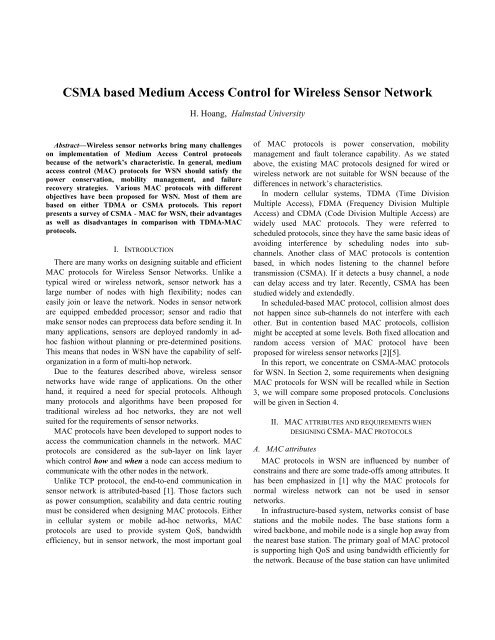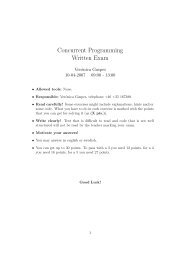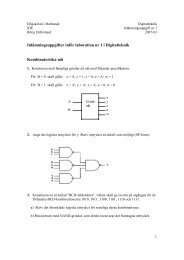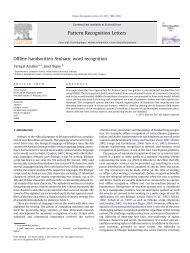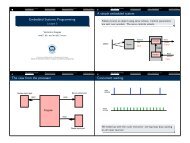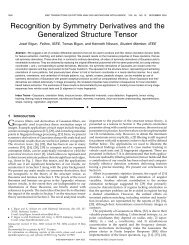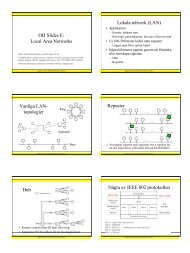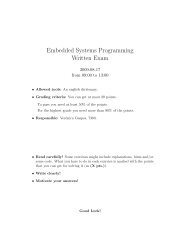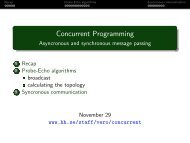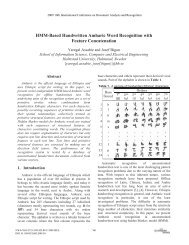CSMA based Medium Access Control for Wireless Sensor Network
CSMA based Medium Access Control for Wireless Sensor Network
CSMA based Medium Access Control for Wireless Sensor Network
Create successful ePaper yourself
Turn your PDF publications into a flip-book with our unique Google optimized e-Paper software.
<strong>CSMA</strong> <strong>based</strong> <strong>Medium</strong> <strong>Access</strong> <strong>Control</strong> <strong>for</strong> <strong>Wireless</strong> <strong>Sensor</strong> <strong>Network</strong>H. Hoang, Halmstad UniversityAbstract—<strong>Wireless</strong> sensor networks bring many challengeson implementation of <strong>Medium</strong> <strong>Access</strong> <strong>Control</strong> protocolsbecause of the network’s characteristic. In general, mediumaccess control (MAC) protocols <strong>for</strong> WSN should satisfy thepower conservation, mobility management, and failurerecovery strategies. Various MAC protocols with differentobjectives have been proposed <strong>for</strong> WSN. Most of them are<strong>based</strong> on either TDMA or <strong>CSMA</strong> protocols. This reportpresents a survey of <strong>CSMA</strong> - MAC <strong>for</strong> WSN, their advantagesas well as disadvantages in comparison with TDMA-MACprotocols.I. INTRODUCTIONThere are many works on designing suitable and efficientMAC protocols <strong>for</strong> <strong>Wireless</strong> <strong>Sensor</strong> <strong>Network</strong>s. Unlike atypical wired or wireless network, sensor network has alarge number of nodes with high flexibility; nodes caneasily join or leave the network. Nodes in sensor networkare equipped embedded processor; sensor and radio thatmake sensor nodes can preprocess data be<strong>for</strong>e sending it. Inmany applications, sensors are deployed randomly in adhocfashion without planning or pre-determined positions.This means that nodes in WSN have the capability of sel<strong>for</strong>ganizationin a <strong>for</strong>m of multi-hop network.Due to the features described above, wireless sensornetworks have wide range of applications. On the otherhand, it required a need <strong>for</strong> special protocols. Althoughmany protocols and algorithms have been proposed <strong>for</strong>traditional wireless ad hoc networks, they are not wellsuited <strong>for</strong> the requirements of sensor networks.MAC protocols have been developed to support nodes toaccess the communication channels in the network. MACprotocols are considered as the sub-layer on link layerwhich control how and when a node can access medium tocommunicate with the other nodes in the network.Unlike TCP protocol, the end-to-end communication insensor network is attributed-<strong>based</strong> [1]. Those factors suchas power consumption, scalability and data centric routingmust be considered when designing MAC protocols. Eitherin cellular system or mobile ad-hoc networks, MACprotocols are used to provide system QoS, bandwidthefficiency, but in sensor network, the most important goalof MAC protocols is power conservation, mobilitymanagement and fault tolerance capability. As we statedabove, the existing MAC protocols designed <strong>for</strong> wired orwireless network are not suitable <strong>for</strong> WSN because of thedifferences in network’s characteristics.In modern cellular systems, TDMA (Time DivisionMultiple <strong>Access</strong>), FDMA (Frequency Division Multiple<strong>Access</strong>) and CDMA (Code Division Multiple <strong>Access</strong>) arewidely used MAC protocols. They were referred toscheduled protocols, since they have the same basic ideas ofavoiding interference by scheduling nodes into subchannels.Another class of MAC protocols is contention<strong>based</strong>, in which nodes listening to the channel be<strong>for</strong>etransmission (<strong>CSMA</strong>). If it detects a busy channel, a nodecan delay access and try later. Recently, <strong>CSMA</strong> has beenstudied widely and extendedly.In scheduled-<strong>based</strong> MAC protocol, collision almost doesnot happen since sub-channels do not interfere with eachother. But in contention <strong>based</strong> MAC protocols, collisionmight be accepted at some levels. Both fixed allocation andrandom access version of MAC protocol have beenproposed <strong>for</strong> wireless sensor networks [2][5].In this report, we concentrate on <strong>CSMA</strong>-MAC protocols<strong>for</strong> WSN. In Section 2, some requirements when designingMAC protocols <strong>for</strong> WSN will be recalled while in Section3, we will compare some proposed protocols. Conclusionswill be given in Section 4.II. MAC ATTRIBUTES AND REQUIREMENTS WHENDESIGNING <strong>CSMA</strong>- MAC PROTOCOLSA. MAC attributesMAC protocols in WSN are influenced by number ofconstrains and there are some trade-offs among attributes. Ithas been emphasized in [1] why the MAC protocols <strong>for</strong>normal wireless network can not be used in sensornetworks.In infrastructure-<strong>based</strong> system, networks consist of basestations and the mobile nodes. The base stations <strong>for</strong>m awired backbone, and mobile node is a single hop away fromthe nearest base station. The primary goal of MAC protocolis supporting high QoS and using bandwidth efficiently <strong>for</strong>the network. Because of the base station can have unlimited
power supply and mobile node can be recharged in cellularsystem, power consumption is only considered as thesecondary requirement.Mobile ad-hoc network (MANET) is closer to thewireless sensor network than the infrastructure-<strong>based</strong>networks. The nodes in MANET are portable batterypowereddevices, they can be replaced by the user and thuspower consumption is also the secondary attribute. In thiscase, MAC protocol has a task of <strong>for</strong>ming the networkinfrastructure and maintaining the mobility, and a primarygoal of provision of high QoS under mobile condition.In wireless sensor networks, power conservation is themost important attribute. Collision is one factor that leads towaste of energy, hence, all MAC protocols are designed toavoid collision by different ways. The idle listening andunnecessary data sending are also reasons of wastingenergy. In many cases, nodes are put into sleeping modewhen there is no data transmitting in the network or radio isturned off to save power consumption.It has been mentioned in Section 1 that, nodes in sensornetwork can be deployed randomly, thus MAC protocolshave to be able to adapt self-organized and changingtopologies. Some attributes of MAC in WSN can be placedin the order:- Collision avoidance- Energy efficiency- Scalability and adaptively- Throughput and latencyB. Requirement when designing <strong>CSMA</strong>-<strong>based</strong> MACprotocols <strong>for</strong> WSNIn most of <strong>CSMA</strong> schemes (with or without collisiondetection), packet transmission occur with stochasticdistribution, which is very different from sensor network. Insensor network, it is common that traffic is collectivestructure while existing <strong>CSMA</strong> protocols mostly used <strong>for</strong>point-to-point communication traffic (i.e., Ethernet). One ofthe requirements when designing <strong>CSMA</strong> protocol <strong>for</strong> WSNis re-exploring <strong>CSMA</strong> strategies with a differentassumption.With <strong>CSMA</strong>, a node wishing to transmit first, listens tothe medium to determine if another transmission is inprogress. If the medium is in use, the node must wait. If themedium is idle, the node can send data. The collision mayhappen if two nodes want to transmit at the same time. Sothe node wishing to transmit listens to the medium obeysthe following rules:1. If the medium is idle, transmit otherwise go to step 22. If the medium is busy, continue to listen until thechannel is sensed idleIt is obvious that listening is effective if all the nodes canhear from each other. It is not possible in sensor networksince the number of nodes are very large. However, nodesare able to listen to each other if radio is turn on, it’s wasteof energy. <strong>CSMA</strong> protocols <strong>for</strong> sensor network must reducethe length of carrier sensing and have the opportunity toturn off radio.In the back-off <strong>CSMA</strong> mechanism, a node transmits withthe probability p if the medium is idle and with probability(1-p) to back-off and restart carrier sense. In sensornetworks, traffic is superposition of different periodicstream [5] there<strong>for</strong>e; back-off should not just retrain a nodefrom sending <strong>for</strong> back-off period.III. REVIEWING PROPOSED PROTOCOLSA. Combine <strong>CSMA</strong> and adaptive rate control scheme [5]Woo and Culler proposed a MAC protocol <strong>for</strong> wirelesssensor networks which combines <strong>CSMA</strong> and an adaptiverate control mechanism. In this protocol, a random delayprior is optionally added to listening to avoid repeatedcollision so that the listening period can be random orconstant. The back-off time is used as “phase shift”. Ratecontrol mechanism presented in the paper [5] is verysimple. A node in the sensor network attempts to inject apacket. If the packet is successfully injected, it means thatthe transmitting rate can be increased. If the injection of thepacket is failed, the rate has to be decreased. By that way,each node in the network can dynamically adjust its originalrate of injecting packet into the network.It has been concluded in this protocol that constantlistening period is energy efficient and random delayprovides robustness again repeated collision. Fixed windowand exponential decrease back-off scheme wererecommended to maintain proportional fairness in thenetwork. The proposed adaptive rate control (ARC)mechanism uses a linear increase and multiplicativedecrease approach to control the transmission rate ofapplication. While linear increase brings more aggressivechannel competition, the multiplicative decrease controlsthe transmission failure. This mechanism adapts the rate oftransmission of both original and route-thru traffic withoutany use of MAC control packet.The scheme presented in [5] is totally computational,which is much cheaper in energy cost than operations onradio. The amount of computational is acceptable within thesensor network computation capacity.One more interesting point is ARC also attempts to avoid
hidden node problem in multihop network. Thetransmission rate is constantly tuned and the phase is alsochanged so that the aggregate periodic stream of traffic willnot collide.B. Collision minimizing <strong>CSMA</strong> <strong>for</strong> WSN [7]Collision-minimizing <strong>CSMA</strong> protocol, named <strong>CSMA</strong>/p*,is nonpersistent carrier sense multiple access (<strong>CSMA</strong>) withnonuni<strong>for</strong>m probability distribution p* is chosen such thatnodes use to randomly select contention slots. The protocolhas presented a method to treat special workload condition:event-driven workload. In event-driven workload, manynodes send traffic at time of an event, not all event reportsare needed and events occur rarely related the time neededto deliver required event reports. Authors showed that<strong>CSMA</strong>/p* is optimal in the sense that p* is the uniqueprobability distribution that minimize collisions betweencontending stations.Some example of sensor network that can generate event<strong>based</strong>traffic patterns: Room monitering Power-saving in ad-hoc networks Indoor location systemsIn those applications, latency, not throughput, isconsidered as per<strong>for</strong>mance-limiting factor. The goal ofminimizing the latency of the first few successfultransmissions in an event-<strong>based</strong> traffic patterns has beenproposed in [7].The author made an assumption that the traffic isgenerated with main characteristics: An event can trigger a synchronize burst oftransmissions from a large number f sensor nodes. Although a large number of nodes may decide totransmit but the application at the data sink may needonly few of them. The number of sending nodes can change quickly.The main research question in [7] is: If N sensorssimultaneously and independently pick one of K slots atsome point in time, what is the probability distribution(named p*) on slot that yields the maximum probability ofcollision-free transmission?The solution says that the optimal probability <strong>for</strong>choosing the first of K slots is1 − fK−1( N)N − fK−1( N)f ( ) K −1 N presents the feedback effect from (K-1)previous slots.The paper also compared optimal nonpersistent withpersistent <strong>CSMA</strong>, and discussed possible implementationdirections <strong>for</strong> optimal protocol.C. <strong>Medium</strong> <strong>Access</strong> <strong>Control</strong> with Coordinated AdaptiveSleeping <strong>for</strong> WSN ( S-MAC)S-MAC is designed specially <strong>for</strong> wireless sensor networkby Ye et al. [9]. S-MAC is built on contention-<strong>based</strong>protocols in order to remain the flexibility of contention<strong>based</strong>protocols while improve the energy efficiency inmultihop network. S-MAC also achieves good scalabilityand collision avoidance by utilizing a combined schedulingand contention scheme.S-MAC uses a complete listen/sleep frame after TDMAframe <strong>for</strong> the sleep/wakeup cycle to allow the nodespending most of the time in the sleep mode. In S-MACprotocol, all nodes are free to choose listen/sleep schedules,and share with their neighbor. Nodes scheduletransmissions during the listen time of the destinationnodes.The collision avoidance in S-MAC is similar to IEEE
802.11 DCF. Contention only happens at the receiver’slisten period. S-MAC puts a duration field in each packet toindicate how long it need to keep silent, by this way, it putsthe node into sleep mode so that S-MAC can save energy.However, there are some disadvantages of S-MAC. Byusing S-MAC the latency can increase. Each message has towait <strong>for</strong> one sleep cycle on each hop, so latency which ismeasured by time <strong>for</strong> message to travel over several hopsincrease.It’s necessary to look at some trade-off of S-MAC, suchas energy vs. latency and throughput. S-MAC reduces theenergy consumption but increases the latency so thethroughput is decrease. It has been shown in [9] that, theoverall per<strong>for</strong>mance depends on the load of the network.Periodic sleep mode provides better per<strong>for</strong>mance in thelight traffic load than in the heavy traffic load.D. IEEE802.11 MAC <strong>for</strong> dedicated short rangecommunication in intelligent transport systemDSRC (Dedicated Short Range Communication) is shortto-medium-rangecommunication service that used in bothvehicle-to-roadside (v2r) and vehicle-to-vehicle (v2v)environment. There is strong requirement of designing asuitable MAC and network layer techniques to supportDSRC environment.Two keys scenarios in DSRC applications weredescribed in [10]: a distributed mobile multihop (I) networkand a centralized mobile single-hop network (II). Scenario Icorresponds to peer-to-peer communication betweenvehicles while scenario II corresponds to vehicles toroadside communication. The necessary requirements ofdesigning MAC protocol <strong>for</strong> DSRC environments shouldfocus on: multihop and high-mobility environments.Existing IEEE 802.11 has some limitations in DSRCenvironments. In 802.11 protocols, the fundamentalmechanism <strong>for</strong> media access is the distributed coordinationfunction (DCF). DCF is used to support ad hoc networkwithout the need <strong>for</strong> any infrastructure. Another MACprotocols that used in the network infrastructure <strong>based</strong> (likemedia access points) is centralized MAC protocol withpoint coordinator function (PCF). PCF can be used toarchive collision-free time-bounded medium access.A main problem with 802.11 DCF in multihop network is“blocking” when a node is hidden. In DSRC environments,especially with vehicle to roadside (v2r) communication,when the vehicles move very fast and passing by theroadside unit, there is a requirement of very highdownloaded rate in a short time. There<strong>for</strong>e, an efficientprotocol with low overhead is preferred in such conditions.J. Zhu and S. Roy have summarized the progress up todate concerning the modeling and analysis of 802.11 MACin the key areas: DCF modeling, achieving fairness, qualityof service, and high-efficiency data transmission. The mainconclusions from the article are: We should design an enhanced MAC layer from802.11 standards with open interfaces to integratenew solutions. An example is adjusting thecontention window (CW) dynamically to meetpredefined requirement such as: maximumsaturation, throughput, bounded delay, fairness… The effect of high mobility in ad hoc network isimportant factor when designing MAC protocol <strong>for</strong>DSRC environments.IV. COMPARISION <strong>CSMA</strong>-MAC & TDMA-MACAs mention in Section I, <strong>CSMA</strong> <strong>based</strong> protocols do notdivide the common channel into sub-channel or pre-allocatethe channel <strong>for</strong> individual node in the network. Instead, allnodes share the common channel and it is allocated ondemand.First, we look at the advantages of <strong>CSMA</strong> <strong>based</strong>protocols compared with scheduled <strong>based</strong> protocols. It isobvious that, with <strong>CSMA</strong> protocol we do not need toschedule in advance, it is more dynamical and flexible tochange. <strong>CSMA</strong> protocols allocate resource on-demand, ifsome nodes in the network have more traffic load than othernodes or so some regions have higher density than theothers do, <strong>CSMA</strong> protocols are easier to redistribute thenetwork resource. On the other hand, we can say that<strong>CSMA</strong> protocols are more scalable than schedule protocols,especially when the network topologies change. There is norequirement to <strong>for</strong>m communication clusters and peer-topeercommunication is supported directly. <strong>CSMA</strong> protocolsdo not need the time synchronization as in TDMA protocol.However, <strong>CSMA</strong> <strong>based</strong> protocols have somedisadvantages compared to schedule <strong>based</strong> protocols. Themajor disadvantage is its inefficient usage of energy. Nodeshave to turn-on during listening mode, it waste energy.There is still collision in some levels.V. SUMMARYThe paper reviews <strong>CSMA</strong>-<strong>based</strong> MAC protocol <strong>for</strong>wireless sensor networks. MAC protocols <strong>for</strong> WSN have tobe able to save the power consumption, manage themobility, self-organization, and failure recovery strategies.Both schedule <strong>based</strong> and <strong>CSMA</strong> <strong>based</strong> MAC protocolsusing in wireless sensor network have advantages anddrawbacks. It depends on applications we can choose thesuitable protocols. The combination of these two protocols
is an efficient way of implementing special MAC protocol<strong>for</strong> WSN, namely hybrid protocols.However, there are still many challenges in designingMAC protocols <strong>for</strong> WSN. The key challenges remains, suchas to provide predictable delay, guaranteed network’sthroughput and at the same time reduce the overheadpackets to minimize the energy consumption.REFERENCES[1] I. F. Akyildiz et al., “ <strong>Wireless</strong> sensor network: a survey,” Computer<strong>Network</strong>s 38, 2002 , pp. 393–422.[2] K. Sohrabi et al., “Protocol <strong>for</strong> self-Organization of a <strong>Wireless</strong> <strong>Sensor</strong><strong>Network</strong>”, IEEE Personal Communication, Oct. 2000, pp. 16–27.[3] T. Zheng et. al., “ PMAC: An Adaptive Energy-Efficient MACProtocol <strong>for</strong> <strong>Wireless</strong> <strong>Sensor</strong> <strong>Network</strong>s,” in Proceedings of 19thIEEE International Parallel and Distributed Processing Symposium,2005. Proceedings.[4] C. H. Yeh, “A collision-controlled MAC protocol <strong>for</strong> mobile ad hocnetworks and multihop wireless LANs” to be appeared in Proceedingof IEEE Global Telecommunications Conference, 2004.[5] A. Woo et. al., A transmission control scheme <strong>for</strong> media access insensor network, Proceeding of ACM MobiCom’01, Rom, Italy, July2001, pp. 221-235.[6] Y. E. Sagduyu and A. Ephremides, The problem of medium accesscontrol in wireless sensor networks, IEEE <strong>Wireless</strong> Communication,December 2004.[7] Y. C. Tay, et al., Collision-Minimizing <strong>CSMA</strong> and its Applications to<strong>Wireless</strong> <strong>Sensor</strong> <strong>Network</strong>[8] V. Paxson and S. Floyd, “Wire area traffic: The failure of poissonmodeling,”[9] W. Ye and J. Heidemann, medium <strong>Access</strong> <strong>Control</strong> with coordinatedadaptive sleeping <strong>for</strong> WSN, IEEE/ACM transaction on networking,Vol. 12, No. 3, June 2004.[10] J. Zhu and S. Roy, “MAC <strong>for</strong> Dedicated Short RangeCommunications in Intelligent Transport System,” IEEECommunication magazine, December 2003.


